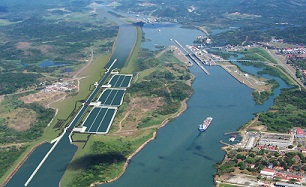Expanded Panama Canal to see increasing gas tanker traffic

The third set of locks for the expanded Panama Canal (shown at right), and the existing locks (shown on left) in May 2016. Photo credit: Panama Canal Authority.
Adrienne Blume, Editor, Gas Processing and Executive Editor, Hydrocarbon Processing
Panama government officials estimate that 20 MMtpy of LNG will pass through its newly expanded waterway, the equivalent of nearly one tanker per day. Most of the supplies will travel to Asia, the world’s largest LNG-importing region. The economies of South Korea and Taiwan stand to benefit greatly from the $5.3-B expansion.
Japan and China are also expected to import LNG through the enlarged canal.
The expansion project broke ground in 2007. Its debut is serendipitous for US gas producers, as the shale boom has sent domestic supplies surging, and drillers are looking to send their fuel to markets abroad.
At present, the Panama Canal can accommodate ships carrying 5,000 containers, but the expansion will allow vessels with 14,000 containers to pass. The new locks will be able to accommodate vessels up to 160 feet wide and 1,200 feet long, which means that ships carrying LNG will finally gain access. The larger waterway will help US gas producers avoid longer trips around South America, cutting transits to Asian markets and increasing profits.
The volume projected by the Panama Canal Authority represents about 8% of global
LNG trade, equivalent to nearly 300 ships a year. Two shipping alliances, CKHYE and G6, have already announced plans to upgrade the size of the ships they use for the US-to-Asia route via the Panama Canal. The Canal expects its total revenues to increase 17% in 2017 to $2.8 B as a result of the expansion.

- Gasum powers Equinor's platform supply vessel with bio-LNG
- ADNOC deploys pioneering AI-enabled process optimization technology
- Mexico Pacific announces long-term LNG SPA with POSCO International
- ONEOK to acquire Medallion and controlling interest in EnLink for $5.9 B
- Golar LNG signs EPC deal for $2.2-B MK II FLNG conversion project



Comments